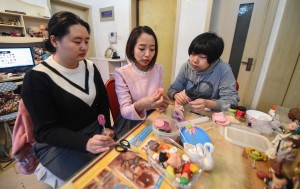北欧绿色邮报网报道(记者陈雪霏)--瑞典今天气温零下19度到零下11度。虽然天气晴朗,但是格外的冷。
昨天前天下雪,但这次雪没有马上化。在今后的五天里几乎天天有雪,但是到周日,气温可能回零。明天依然是零下,但回到-5到-8度之间。
希望大家保暖,外出要多穿点儿,否则就在家里锻炼吧!
北欧绿色邮报网报道(记者陈雪霏)--瑞典今天气温零下19度到零下11度。虽然天气晴朗,但是格外的冷。
昨天前天下雪,但这次雪没有马上化。在今后的五天里几乎天天有雪,但是到周日,气温可能回零。明天依然是零下,但回到-5到-8度之间。
希望大家保暖,外出要多穿点儿,否则就在家里锻炼吧!
北欧绿色邮报网消息(记者陈雪霏)--北欧绿色邮报网日前发出消息,向广大华人华侨征集2015瑞典华人华侨十大新闻。希望瑞典华人华侨踊跃推荐提名。评选十大新闻活动将在2月1日结束。2月5日公布。
每人可以提十条新闻事件,也可以提一条新闻事件。最少一条,最多10条。
请发到邮箱 info@greenpost.se
北欧绿色邮报网报道(记者陈雪霏)--1月5日,长春李晶在展示萌宝主题的面塑作品。

“面揉心声”是面塑师李晶的传承主题和创业梦想,33岁的她从事并探索面塑这项中国民间艺术5年来,已完成万余件“萌萌哒”面塑作品。她说,要用彩色的面揉出孩子们喜欢的艺术形象,让这项有着千余年历史的“老手艺”能够以创新的方式传承和普及下去。

2001年毕业于吉林艺术学院的李晶目前是吉林省民间文艺家协会会员、非遗传承人,5年前一次偶然的机会让她接触到面塑,使她燃起了童年时代对街边摊手工艺品的憧憬。于是,她放弃了艺术设计工作,选择面塑为创业项目。天分、基础、梦想等因素使然,使她的作品风格独树一帜,并多次受邀在长春市一些中小学授课。


李晶如今更多地将创作视角锁定在引起孩子们共鸣的题材上。她说,在大众创业、万众创新的时代,她既要坚持传统也要不断创新,“如今,靠做面塑养家糊口不成问题了,但我还想出一本书,让更多的人了解、学习到这门‘老手艺’。”
Xuefei Chen Axelsson
STOCKHOLM, Jan. 6(Greenpost)–This morning, it was my turn to work for the Church. I went there at 10:00. As soon as I arrived in the kitchen where we should prepare coffee and food for lunch after the God’s service.
A colleague immediately talked about North Korea’s hydrogen bomb. This was the fourth time, north korea held nuclear test.
“It caused a lot of concern around the world.” said David. Due to my poor Swedish, I thought he was talking about something else. But as soon as I realized the news, I felt a curse.
Yes, Kim Jong-un should be condemned. The calmness of the world is not normal.
Last year, when we celebrated the New Year, I was happy that the third world war didn’t happen. But this year, I was neither happy nor sad. It was quiet. But I didn’t know what this quietness meant.
The war is at someone’s hands and the crazy one is holding the butt of the grenade. That is the situation we are facing.
China is surrounded by the nuclear countries. The US knew North Korea developed nuclear but didn’t know it should help it or hold it.
What do you think? dear reader? What shall we do?
As editor of Green Post, my call is to stop any war or conflict, let’s sit down and talk. Does it work?
北欧绿色邮报网报道(记者陈雪霏)--12月4日,在“超级宣纸”生产车间,工人在进行提帘作业。
近日,位于“中国宣纸之乡”安徽泾县的中国宣纸股份有限公司向宣纸抄制的极限发起挑战,经44名技艺精湛的捞纸师傅携手抄制,一张长达11.4米、宽达3.6米的“超级宣纸”成功诞生。
据悉,宣纸作为传统手工珍品,具有尺寸越大、抄制难度越大、艺术价值越高的特点,而“超级宣纸”成品纸尺寸达11米×3.3米,是真正意义上的传统、手工、二帘水的“超三丈三”宣纸。
该纸制作需要捞纸及辅助工52人、晒纸工20人、剪纸工4人。“三丈三”巨型宣纸主要适用于创作巨幅书画艺术作品,它的成功抄制,为书画艺术家们创作大型书画作品提供了特种宣纸,也为传承与发展宣纸技艺作出了贡献。


新华社记者 刘军喜摄
BEIJING, Dec. 31 (Xinhua) — Several laws and regulations will take effect in 2016, and change the day-to-day lives of the Chinese people.
From allowing a second child and making it easier for migrant workers to settle down in big cities, to measures that make the stock market more stable and market-oriented, these new rules touch on the deeper problems facing the Chinese and will go down in history.
A FAMILY AFFAIR
From the first day of 2016 the lives of tens of millions of Chinese couples will change when the amended family planning law takes effect,allowing all couples to have two children.
This historic move is part of efforts to balance the population structure.
Chen Li, who works at a public institute in northwest China’s Shaanxi Province, has always wanted a second child.
“Thanks to the amended law, my husband and I can plan for another child. My daughter will have a younger sibling, and they can take care of each other,” said Chen, who is in her forties.
China’s family planning policy was first introduced in the 1970s to rein in the surging population. For decades, most urban couples were limited to one child, while rural couples were allowed to have two children if the first was a girl.
The policy gradually relaxed as a number of social problems arose. In 2013, China began to allow couples to have a second child if either parent was an only child.
Guo Zhigang, a sociologist with Peking University, said around 35 percent of the population will be over 60 by 2050. “The new law will help balance the decreasing labor force and aging population,” he added.
CITY LIFE
The new year also brings good news for the 250 million migrant workers in cities, mainly from rural areas. They will be able to apply for residence permits that will give them better access to local public services from Jan. 1.
According to the new regulation, applicants must have lived in the city in which they are applying for residency for at least six months and either have a stable job, stable place to live or be studying.
Those granted the new residence permits will gain access to more basic public services, including nine years of compulsory education for children and basic health care. The new permits will also bring conveniences such as passport issuance and automobile registration.
“For decades, migrants have experienced inconveniences in places they work and live in because they are not locals,” said Wang Han, 31, a software engineer in Beijing. Wang came to Beijing in 2006 from the northeast province of Jilin.
Although Beijing has issued residence permits since 2003 for migrants who have made extraordinary contributions or those who are classified as urgently needed talent, Wang found it difficult to get one. “The regulation will ensure migrants have more equal access to social services received by local ‘hukou’ holders,” said Wang. In China, people with a city’s “hukou” enjoy better educational opportunities, employment support and social welfare.
A STABLE MARKET
China will introduce a circuit breaker next year in addition to the existing daily trading limit for individual stocks to ward off major swings in the country’s stock market.
Market gyrations during the summer this year ended a bull-run of Chinese stocks since late 2014 and wiped out trillions in market value.
The circuit breaker will force trading at exchanges in Shanghai and Shenzhen to suspend for 15 minutes if the Hushen 300 index falls five percent. Trading will halt for the rest of the day if the index plunges more than seven percent.
There were 25 days when the index fell over five percent between the beginning of 2014 and the end of October this year, including 11 days when the decline exceeded 7 percent, data compiled by Ping An Securities shows.
Meanwhile, new stock offerings on the domestic market will see less bureaucratic meddling as registration-based IPO rules will replace the approval-based listing process. The supply of new stocks will gradually increase and more companies can access fundraising through the stock market under more flexible listing requirements.
Under the registration-based IPO rules, regulators will only need to ensure thorough information disclosure for IPOs and let the market determine the value of new stocks rather than hand-pick companies for listing, a practice that has bred corruption among officials who get to decide on which company goes to market.
IT’S EASY TO BE GREEN
A new law on air pollution control will become effective on the first day of 2016. This new legislation was amended and passed this year amid worsening air pollution across China.
Beijing and its surrounding region in northern China were among the regions worst hit by smog containing hazardous air-borne particles measuring less than 2.5 microns in diameter, known commonly as PM 2.5.
China has made similar legislation in the past, but existing regulation has been seen as increasingly outdated and less effective in reducing pollution.
The new law metes out tougher punishments to industries and seeks to curb air pollution at its root.
In the past, companies and organizations that failed to comply with legal requirements on air pollution faced fines of up to 500,000 yuan (around 80,600 U.S. dollars). That limit is gone in the new law, in the hope that reckless polluters will no longer be able to afford to pollute.
The new law also mandates that gasoline be produced at a higher quality and alternative energy used to reduce coal consumption.
Local governments will also be assessed and monitored over what they do to improve air quality. They have largely ignored environmental protection in the past in their growth-at-all-cost approach to economic development. Enditem
BEIJING, Dec. 31 (Xinhua) — China’s supply-side structural reform holds the key to its structural adjustment in the short term and will solidify the bedrock for the sustainable development of its economy in the long run, overseas experts have observed.
Marking a crucial year for China to comprehensively deepen its reforms, 2015 saw the birth of its development blueprint for the next five years amid a decelerated domestic economy and an unstable global one.
At a recently concluded key economic meeting in Beijing, the Chinese government pledged to take steps to push forward a “supply-side structural reform” in 2016 and beyond to support growth through new demand and productivity.
China’s announcement of a supply-side structural reform came at a critical moment, and is considered as an innovative move to guide the world’s second-largest economy under the “New Normal” and a proactive decision to make it internationally more competitive.
NEW IDEAS, NEW MOMENTUM
The choice of supply-side structural reform indicates that China does not intend to employ traditional stimulus measures, Ulises Granados, professor of international relations at Mexico Autonomous Institute of Technology, told Xinhua.
It shows that China is seeking an innovative way to stabilize growth and adjust its economic structure with fresh ideas, thus trying to find a new path for its sustainable economic development, the scholar added.
The Japanese newspaper Nikkei said in a recent report that China’s push for a supply-side structural reform is markedly different from the massive stimulus policies used since the outbreak of the Lehman crisis that triggered the financial earthquake in the global market.
Under the “New Normal,” flooding stimulus measures would no doubt boost economic growth in the short term but not be able to increase potential growth with an ideal rate, while risking huge waste.
The International Monetary Fund said the decline of the global potential growth rate was the major contributor to the sluggish recovery of the world economy.
Figures showed that the average potential growth rate of the emerging economies between 2008 and 2014 was 6.5 percent, 2 percentage points lower than the level before the financial crisis.
As its population dividend dwindles and land resources become more scarce, China’s potential growth rate has also shrunk. However, this leaves room for a supply-side structural reform under the “New Normal” that aspires for more sound growth.
MORE EFFICIENT, BETTER GROWTH
Further shifting China’s focus on the quality instead of quantity of the economy, a supply-side structural reform attaches more importance to structural adjustment and innovation in technology and the system in a bid to make the economic structure more efficient.
The Indian newspaper Economic Times paid attention to China’s reformative move.
“As the effectiveness of boosting growth on the demand side, the government has started to reform the supply-side to make effective use of production factors, including funds, resources, skilled workers, equipment and technologies,” it quoted China Daily as saying in a recent report.
El Pais, a Spanish newspaper, noted that China is attempting to shift its growth model from one dependent on exporting low value-added products and government investment to one driven by domestic demand, innovation and the service industry.
In addition, overseas experts have observed that China’s implementation of the supply-side structural reform also serves its long-term need of sustainable development as well as avoiding the “middle-income trap.”
According to the World Bank standard, China has already become a middle-income country, but a higher ranking requires the Asian nation to register a per capita GDP higher than 12,000 U.S. dollars and escape the so-called “middle-income trap.”
Data revealed that since 1960, out of 101 countries and regions which had managed to be categorized as middle-income economies, only 13 became high-income ones later.
Those that did not reach the high-income category had failed to achieve a technological breakthrough, make economic structural adjustments or innovate their systems. However, a supply-side structural reform may be the answer.
Peter Drysdale, economist and editor at the East Asia Forum at the Australian National University, was confident about China’s progress, describing its transition as “so far so remarkably good.”
Despite the massive size of the country, “China has enjoyed a faster transition to middle income than any country before it,” he said. Enditem
BEIJING, Dec. 31 (Xinhua) — China’s benchmark Shanghai Composite Index ended the year of 2015 with a decline of 0.94 percent amid shrinking turnover on December 31, closing at 3,539.18 points on Thursday.
The benchmark index went up 9.41 percent in the whole year of 2015 with the peak point at 5,178.19 points seen on June 12.
In 2015, the Index recorded an over five-percent intraday rise in three trading days and a more than eight-percent fall in five trading days, according to statistics from Shanghai Securities News.
Balance of intraday margin deposits in accounts for securities trading on Shanghai and Shenzhen bourses averaged 1.15 trillion yuan at the beginning of 2015 and it climbed to as high as 3.3 trillion yuan in the middle of the year. By December 30 2015, the accumulated trading turnover on the two bourses totaled 253 trillion yuan, over three times more than that in 2014.
The number of investors traded on Shanghai and Shenzhen stock exchanges jumped from some 71 million yuan at the beginning of the year to 98.62 million yuan by December 30.
At earlier 2015, the balance of margin financing business on the two stock markets stood at some one trillion yuan and soared to a peak of 2.2 trillion yuan within the year. It went back to a bit over one trillion yuan at the end of the year.
BEIJING, Dec. 31 (Xinhua) — China’s cabinet, the State Council, has issued the Development Plan for National Standardization System Construction (2016-2020), according to the official website of Chinese government on Wednesday.
According to the document, China will basically complete the construction of a modern standardization system that supports national governance system and governance capability and has Chinese characteristics by 2020.
The main tasks of the development plan include optimizing standardization system, boosting standard implementation, improving standardization service capability, and strengthening international standardization work.
The development plan also includes specific plans for standardization in seven key areas, including agriculture and the countryside, manufacturing industry, service industry, social affairs, culture, government administration, and ecological protection, energy saving and emission reduction.
The development plan highlights ten key projects, including the agricultural product safety standardization project, the consumer goods safety standardization project, the energy-saving and emission-reduction standardization project, and the next-generation IT standardization project. (Edited by Li Xiaoyu, Lixy@xinhua.org)
Meanwhile, the Ministry of Industry and Information Technology and the Standardization Administration of China have jointly publicized the Guidance on National Intelligent Manufacturing Standard System Construction (2015), the Xinhua-run cnstock.com reported.
The document clarifies the overall requirement, construction idea and content, and method of organization and implementation for building a national intelligent manufacturing standard system.
According to the document, the national intelligent manufacturing standard system will include five basic standards on foundation, security, management, examination and appraisal and reliability, respectively. Meanwhile, it will include key technological standards on intelligent equipment, intelligent factory, intelligent services, industrial software and big data, and industrial Internet.
The guidance is expected to remove the bottleneck in boosting intelligent manufacturing, which is related to data integration and interconnection. The guidance will be revised in every two or three years. (Edited by Li Xiaoyu, Lixy@xinhua.org)
China to soon surpass U.S. to become top consumer of Chilean wine
SANTIAGO, Dec. 30 (Xinhua) — “China will soon surpass the U.S. as the top consumer of Chilean wine,” Claudio Cilveti, general manager of Vinos de Chile, the country’s wine association, told Xinhua on Wednesday.
According to Cilveti, the sales of Chilean wine have grown by 43 percent in the last five years in China and should grow by around 30 percent in 2016, making the country the second-largest customer.
“Chilean wineries are currently seeing sales of 150 million U.S. dollars a year in China, which are set to reach 180-190 million U.S. dollars (in 2016),” he said.
“I believe that our sales to China can still greatly increase as this country is undergoing a cultural change,” said Cilveti.
According to Cilveti, Chinese people consume less than a liter of wine a year per capita, and he is expecting a change with a new economic model which prioritizes consumption in the country,
Cilveti, who was speaking during a conference on the future of Chilean wine, said that Chile is now the third-largest provider of wine to China, following France and Australia.
“This is a great opportunity as Chinese customers like having long-term relationships. Chilean wines have been warmly received and 25 Chilean wineries now have offices in the country,” he said.
Cilveti also attributed this success to the free-trade agreement signed between the two countries in 2006.
Source Xinhua, editor Xuefei Chen Axelsson
BEIJING, Dec. 30 (Xinhua) — Investment in China’s railways in 2015 is still growing despite an economic slowdown.
China spent 820 billion yuan (126 billion U.S. dollars) on rail projects in 2015 and put more than 9,000 kilometers of new track into operation, meeting its annual targets of 800 billion yuan investment and 8,000 kilometers of new lines, according to China Railway Corporation.
With a newly completed high-speed railway track in the southern Hainan Province, China now has 19,000 kilometers of high-speed rail.
The fast growth of railway construction projects came at a time when the country is enduring continuous deceleration in the growth of fixed-asset investment. In the first 11 months of 2015, fixed-asset investment grew 10.2 percent year on year, slowing from 13.9 percent of growth seen at the beginning of this year. Enditem